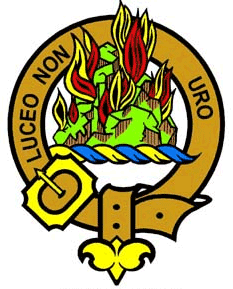MacKenzie Clan
MacKenzie Clan Crest: A mountain in flames.
MacKenzie Clan Motto: Luceo Non Uro (I shine, not burn).
History of Clan MacKenzie:
The MacKenzies held lands in mid-Ross between Kintail on the West Coast and the Black Isle in the East. In 1263, when the Battle of Largs brought to and end the threat of Norse invasion, the Mackenzies were appointed
part of the Royal Bodyguard, an honour they retained until the Battle of Flodden in 1513. For services to Alexander II and Alexander III, Colin MacKenzie was granted the lands of Kintail.
In 1267, they held the castle of Eilean Donan at the mouth of Loch Duich, where their followers, the MacRaes, became the Chief of MacKenzie's hereditary bodyguard. In the early 15th century, Alexander MacKenzie of Kintail was present at the parliament in Inverness at which James I imprisoned the Lord of the Isles. John of Kintail fought at the Battle of Flodden, and John's grandson, Colin, fought for Mary Queen of Scots at the Battle of Langside in 1568.
In 1609, Kenneth MacKenzie, Colin's eldest son, was created Lord MacKenzie of Kintail, and his descendants include the MacKenzies of Pluscarden and Loch-slinn. In 1624, his eldest son was created Earl of Seaforth, and when he died the title passed to his half-brother who later became Secretary of State for Scotland. Another of Colin's son, Sir Ruaridh MacKenzie of Castle Leod, Coigach and Tarbat, was ancestor of the earls of Cromartie. At this juncture, the Clan held lands which extended from the Black Isle to the Outer Hebrides, including the island of Lewis.
The Seaforth MacKenzies religiously supported the Royalist Cause, fighting for the Catholic James VII against William of Orange at the Battle of the Boyne in Ireland in 1690.The 5th Earl was a staunch Jacobite and his lands were forfeited. The Cromartie MacKenzies were also Jacobites and they too had their lands confiscated following the 1745 Uprising.
Both families were pardoned in the next generation, John, the 4th Earl of Cromartie, raising the 71st Highlanders, which became the Highland Light Infantry.
The main Seaforth line came to an end following a strange prophesy made two generations before the Seaforth earldom was created by 'Coineach Odhar,' also known as 'The Brahan Seer.'
The prophecy foretold that the last of the Seaforth Chiefs would be deaf and dumb and would have four sons all of whom would die before him. This came to pass in 1815.
The unfortunate Brahan Seer was burned in a barrel of tar on the Black Isle, accused of dabbling in Witch Craft.
Over the period of the Highland Clearances in 18th and 19th centuries, tenants of the Seaforth Estates were evicted by the Trustees, but were taken in by the Cromartie MacKenzies. In 1984, the 4th Earl of Cromartie was recognised by the Lord Lyon King of Arms as Chief of Clan MacKenzie.
Sir Alexander Mackenzie (1764-1820), was born in Stornoway, Isle of Lewis, and emigrated to Canada. In 1789, he embarked upon a canoe voyage to the northern ocean, then to the Pacific, later writing an account of his voyage.
Sir George Stewart Mackenzie of Coul (1780-1848) discovered the composition of the diamond and its identity with carbon. William Lyon Mackenzie (1795-1861) was born in Dundee and emigrated to Canada in 1820, where
he ran The Colonial Advocate in Toronto and became a controversial member of the Legislative Assembly.
Alexander Mackenzie (1822-92) was born in Perthshire and moved to Canada in 1842. He became editor of The Reform paper and led the opposition to the Dominion Parliament, becoming Premier in 1873.
William Forbes Mackenzie (1807-62) was Member of Parliament for Peeblesshire from 1837 to 1852 and became Lord of the Treasury. Sir Compton Mackenzie (1883-1973) was a prolific writer whose novels included Whisky Galore and The Monarch of the Glen.
Surname distribution in Scotland: The MacKenzie name is common throughout Scotland. There are particularly high numbers living in the Western Isles (the main islands include Lewis and Harris, North Uist, South Uist, Benbecula and Barra), Highland (including the historic counties of Caithness, Inverness-shire, Sutherland, Nairnshire and Ross and Cromarty), Aberdeenshire (includes all of the historic counties of Aberdeenshire and Kincardineshire with part of Banffshire), Moray (also includes a large area of historic Banffshire), Aberdeen City, Angus (Forfarshire) and Dundee City.
Places of Interest:
Castle Leod, Strathpeffer, Easter Ross. Seat of the earls of Cromartie.
Chanonry Point, Black Isle. There is a memorial to the Brahan Seer, Kenneth of Kintail, who prophesised the end of the MacLenzie of Seaforth line of Chiefs.
Fortrose, Black Isle. There are portraits of the Seaforth MacKenzies kept in the Town Hall.
Eilean Donan, Kyle of Lochalsh, Wester Ross. Castle and famous beauty spot. This was the headquarters of the MacKenzies during the 12th century.
Iona, Argyll. Early MacKenzie chiefs were buried here.
Associated family names (Septs): Charles, Charleson, Clunes, Clunies, Cross, Iverach, Iverson, Iver, Ivory, Kenneth, Kennethson, Kinnach, Kynoch, Leawe, Macaweeney, MacBeolain, MacBeath, MacBeth, MacConnach, MacCure, Maceur, MacIver, MacIvor, MacKenna, MacKenney, MacKerlich, MacKinna, MacKinney, MacKinnie, McKinsey, MacLeay, MacMurchie, MacMurchy, MacQueenie, MacThearliach, MacVanish, MacVennie, MacVinish, MacVinnie, MacWeeny, MacWhinnie, Makiver, Murchie, Murchison, Smart, Tuach, Wigh, Young.
Clan MacKenzie membership prints.

